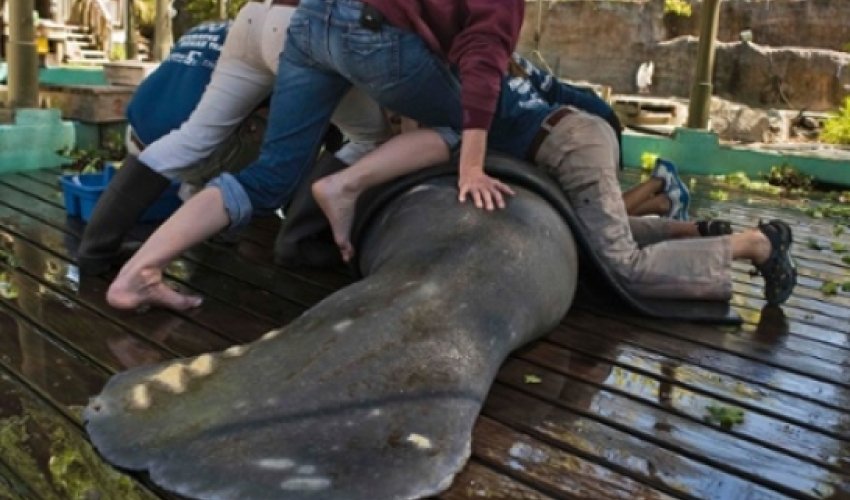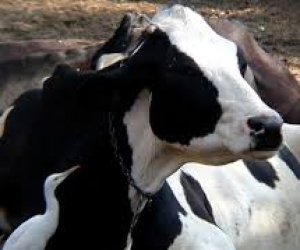Where have all sea cows gone?

The West Indian manatee is an example of evolution optimizing for one thing: taking time to slow down and munch the seagrass. They have no natural predators, just humans and their boat propellers. Individual animals can be identified by the unique pattern of scars on their backs. Their thick skin has kept them going, but maybe not for much longer.
Florida’s manatees are on the IUCN Red List of Endangered Species because “the population is estimated to decline by at least 20% over the next two generations due to anticipated future changes in warm-water habitat and threats from increasing watercraft traffic over the next several decades.”But even slow or no-wake zones and better boater education may not be enough to save the Florida manatee. Another kind of man-made threat – runoff and pollution – is destroying their seagrass beds. More manatees died last year in Florida than ever before recorded.I came home for the holidays to South Florida, where my parents live on the Intracoastal Waterway. Every year around this time, we see many manatees go past the house, heading south to warmer water.But this year, I was puzzled. Where were all the manatees? Then I read about the record die-off in the state of Florida in 2013 – 829 dead manatees, out of an estimated total population of 5,000. That's more than one in six of all the manatees in the state. And 173 of the dead were breeding-age females, according to the Florida Fish and Wildlife Institute.Florida’s manatees are about evenly divided between the state’s east and west coasts. Each experienced its own unfortunate “mortality event” in 2013, making it a particularly bad year for manatees.In southwest Florida, red tide used to be an “unusual mortality event.” Now it’s a “recurring mortality event.” Last year, it killed a record number of 276 manatees in the region. Red tide does form naturally offshore, says Katie Tripp, director of science and conservation for the nonprofit Save the Manatee Club. “When it gets blown inshore, the availability of food is what really determines how long it's going to be able to stick around.”And Floridians keep feeding it. More nutrients in the water – runoff from lawn fertilizer, agriculture, and bauxite mining – means red tide is on the rise. “It seems to be affecting us more,” says Tripp. “When it comes inshore, it goes crazy because it has so much to eat.”Adding to the problem is the western drain out from Lake Okeechobee, which goes into the Caloosahatchee River and comes out in Ft. Myers, Lee County – the epicenter of the red tide. The manatee deaths on the east coast are far more mysterious. In Brevard County, an “unusual mortality event” claimed more than 100 manatee lives last year. The deaths from this unknown cause peaked in early 2013, with more than 50 in March alone, according to Kevin Baxter of the Florida Fish and Wildlife Conservation Commission (FWC). “Commonly, the manatees would die suddenly, as if from shock,” he says. “There were no signs of trauma, and their gastrointestinal tracts were full.”The facts are these: back in 2010, the state experienced prolonged record cold temperatures. This started a “state of disaster in the ecosystem,” says Tripp. The cold knocked out plankton that normally eats algae. Soon, out-of-control algae blooms were blocking sunlight to the 47,000 acres of seagrass.With the seagrass gone, the manatees had to look for other food – and started getting sick. Some of them may have eaten a reddish seaweed called Gracilaria, that could have been toxic. Scientists from the National Oceanic and Atmospheric Administration’s Hollings Marine Laboratory in Charleston, SC, haveisolated toxins from tiny algae that stick to the seaweed. But not all the manatees ate Gracilaria.“Whatever this toxin is around the east coast, it doesn't affect them all equally,” says Tripp. “We don't know if they're just not getting into the troubling food source, or they're somehow processing it differently, or are more resilient. No one's been able to put the pieces together.”“We think they’re eating macroalgae, but we don’t know if that’s what’s causing the deaths,” Baxter says. The FWC’s Fish and Wildlife Research Institute is currently testing for viruses, pathogens, disease, and contaminant screening, he says. “So far, we haven’t been able to determine a cause of death.”The seagrass, which took decades to grow, could take years to come back. As Tripp points out, it only grows seasonally. “It doesn't just grow, grow, grow 12 months a year,” she says. “It grows half a year and then it goes dormant.“I've heard people say that if we can't turn this around soon, it might no longer be a seagrass- dominated system,” Tripp adds. A system dominated by macroalgae “would be a huge shift in the ecosystem that a lot of animals might not be able to adapt to.”I asked Tripp what she would do if she were in charge of manatee management for the state.“I would want to work with all of my agencies to make sure they were doing everything possible to improve water quality,” she says. “And not just little cosmetic fixes. I would also be looking to the federal government for funding. It's quite a mess that's been created, and it's going to take a really big commitment to get it cleaned up and do it right. It's not going to be easy and it's not going to be cheap.“We need to be holding every Floridian accountable – agriculture, business, industry – every citizen,” she adds. “We have to change what we're putting into our waterways.”The state government is taking some steps in the right direction. Last year, the Florida Senate formed a committee to study the potential environmental impact of discharges from Lake Okeechobee into Indian River Lagoon and other nearby bodies of water. Their report, released in November, recommends over $220 million in state funding to improve water quality and expand current storage and flow capacities. It also recommends that the federal government transfer authority over regulatory releases to the Florida Department of Environmental Protection. It remains to be seen whether these recommendations will be implemented.Since the beginning of the new year, I have seen several manatees heading south – a small bit of good news, but nowhere near enough.(theguardian.com)ANN.Az
Similar news
Similar news




































 Photo
Photo 



 Video
Video 

